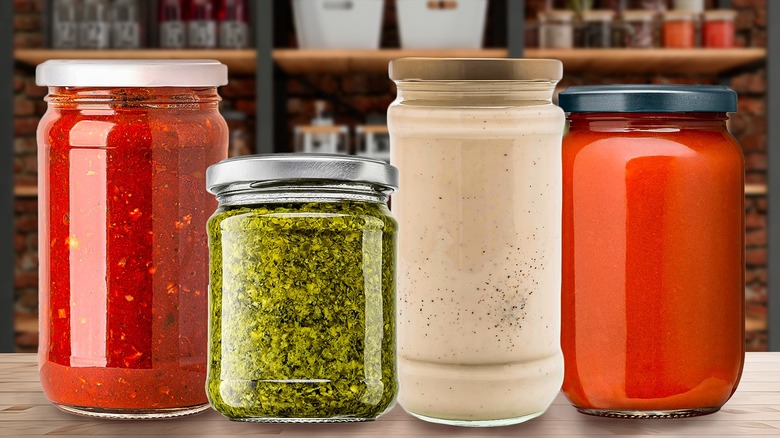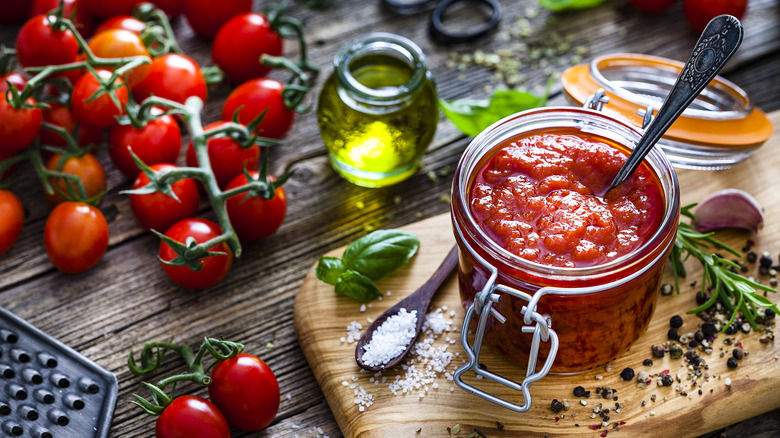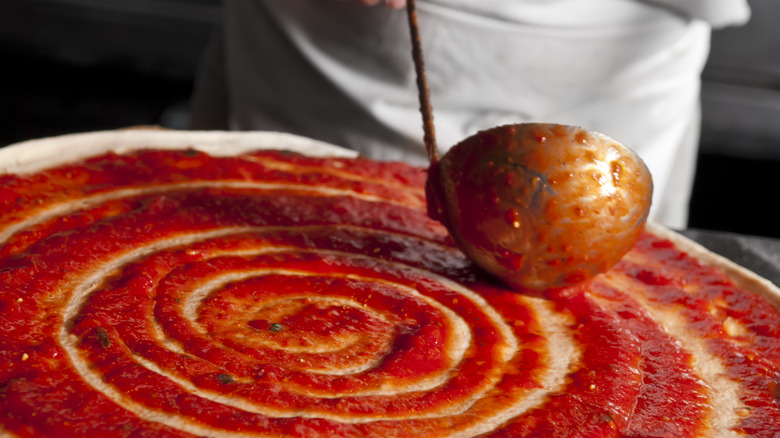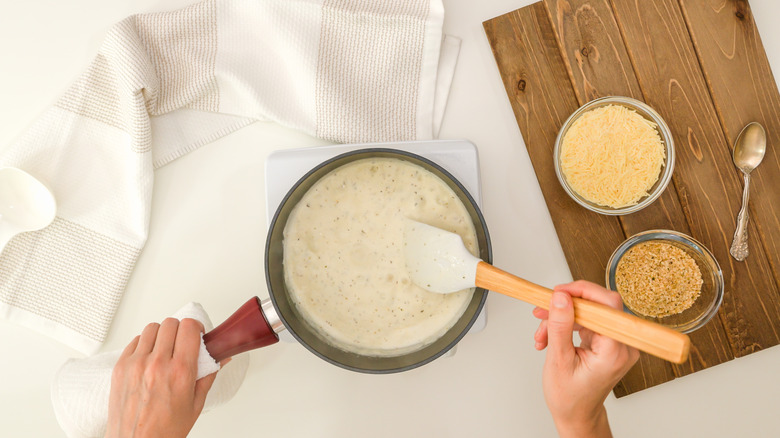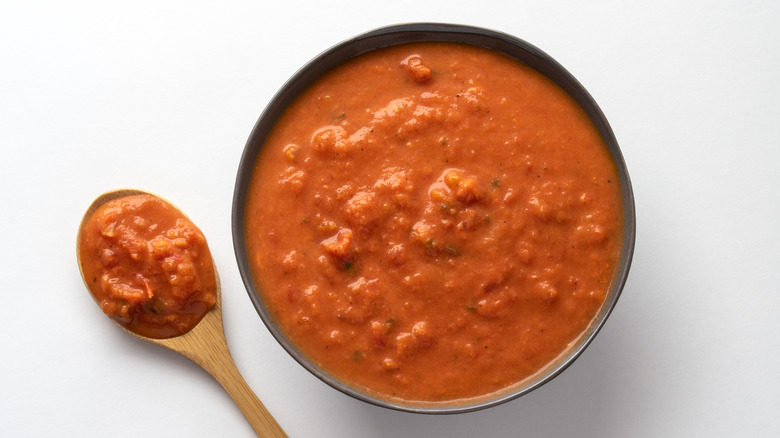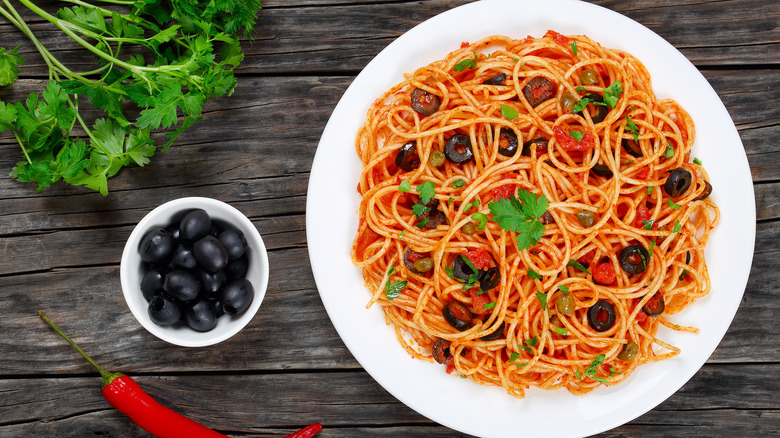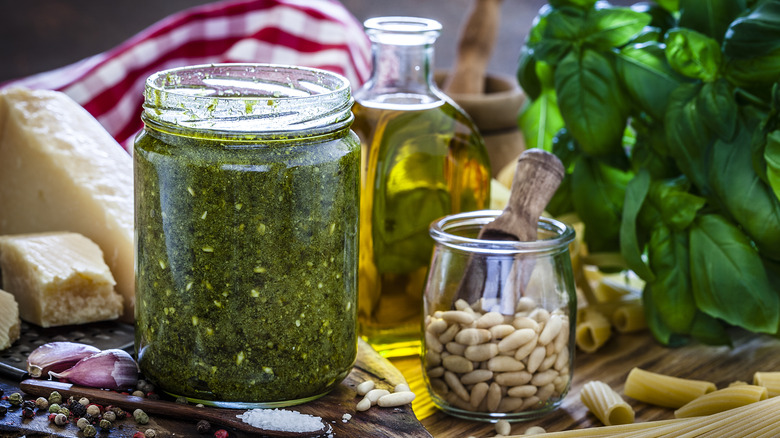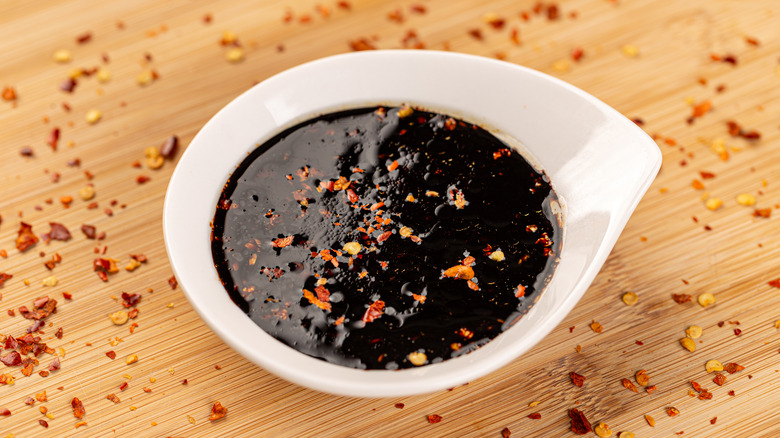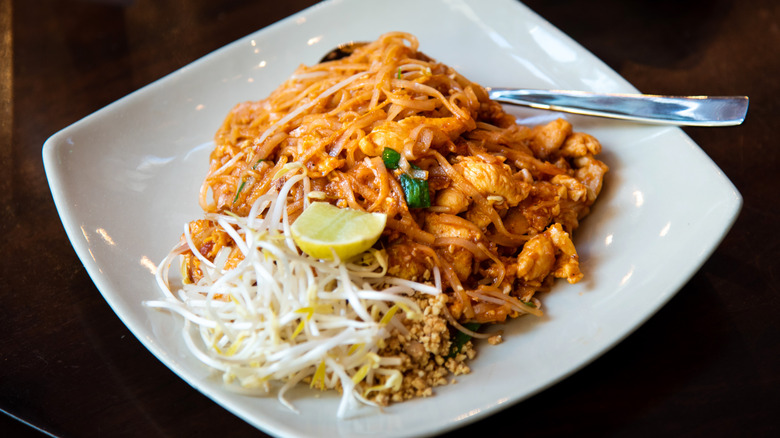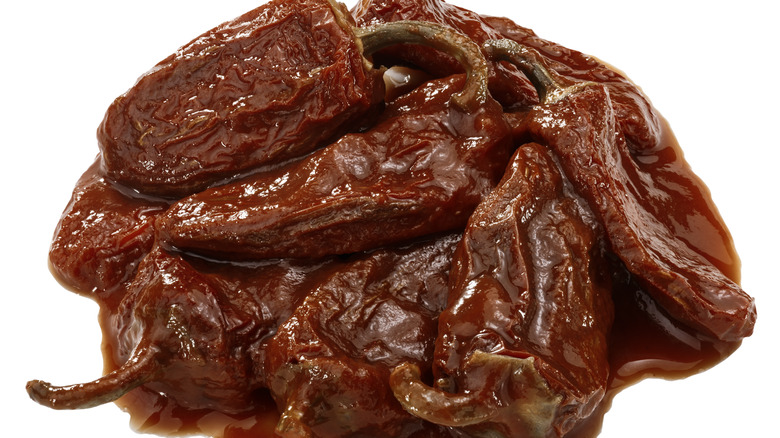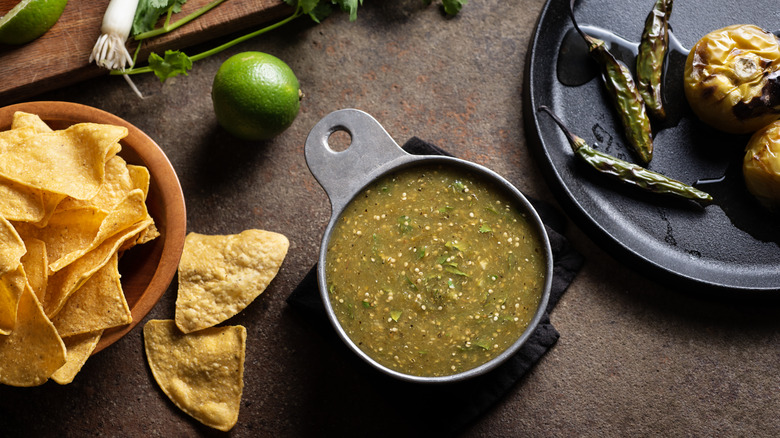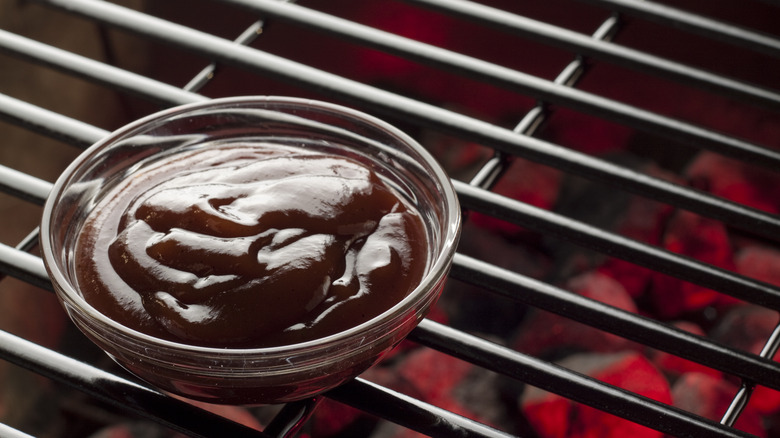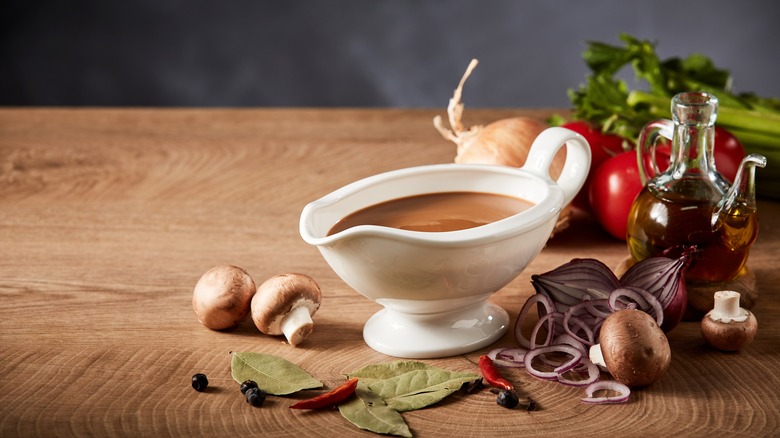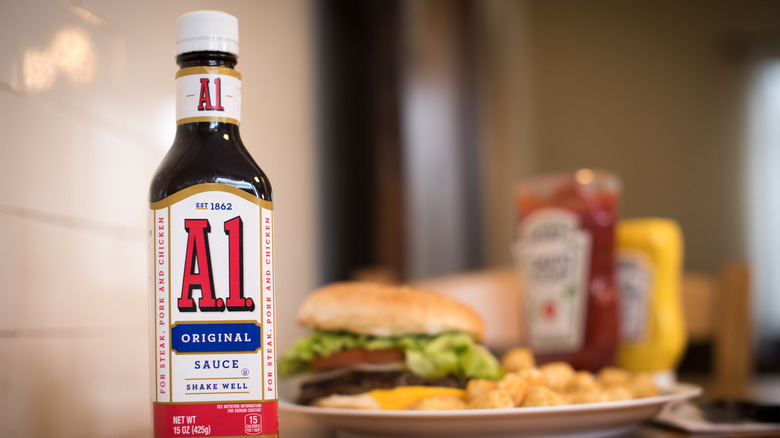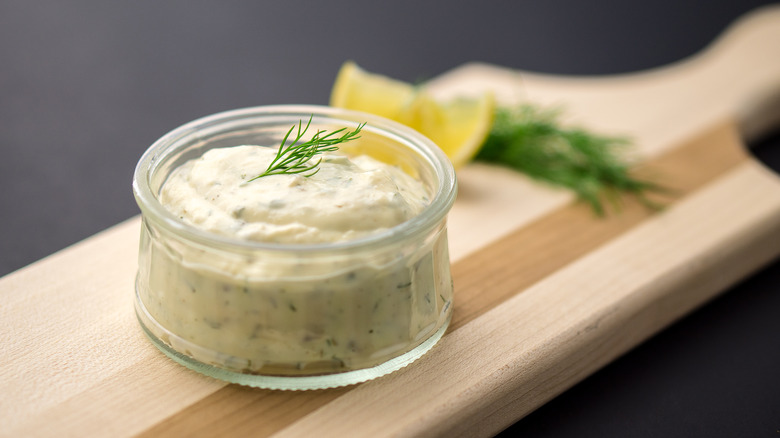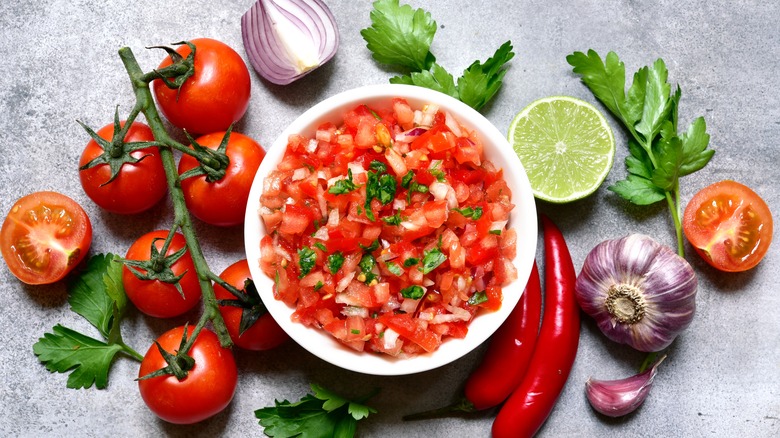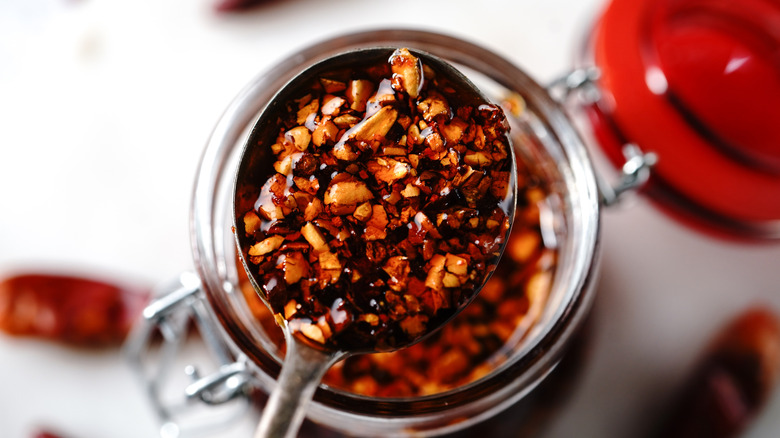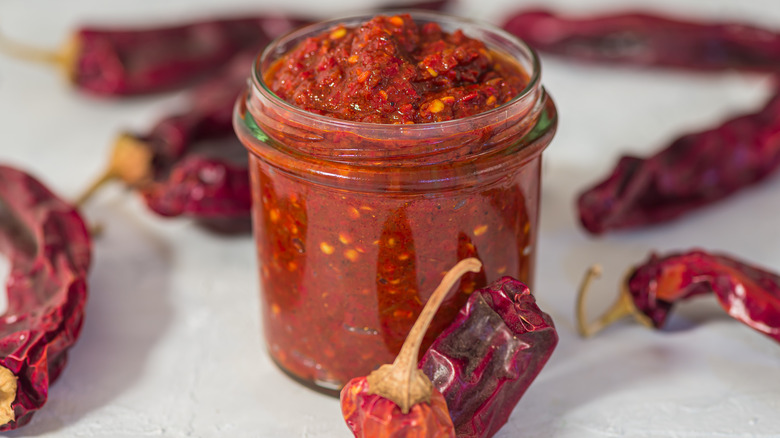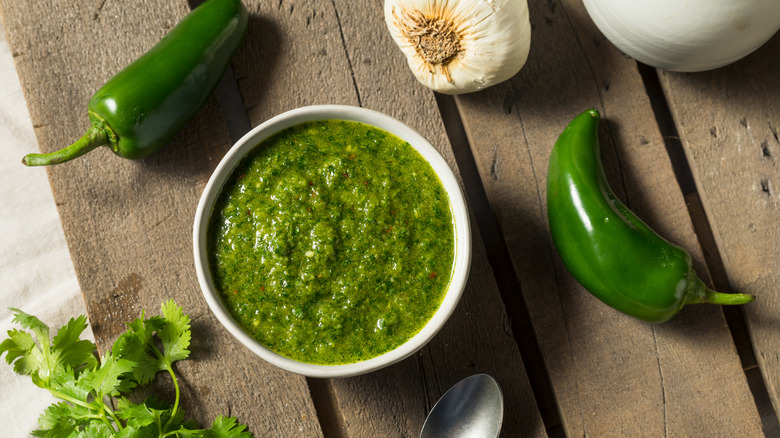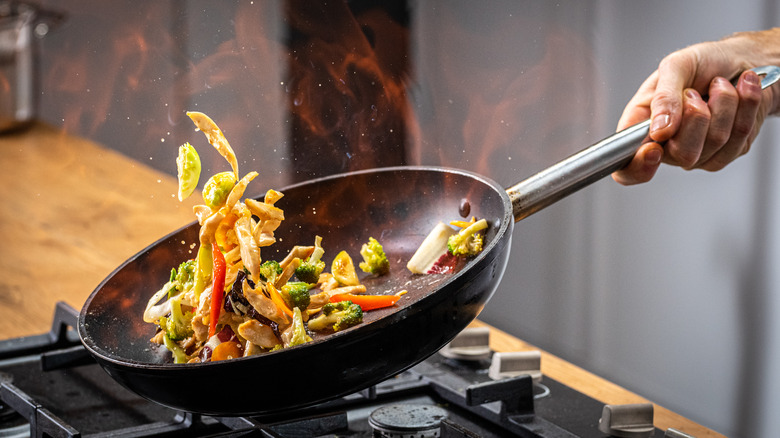22 Canned And Jarred Sauces You Should Keep In The Pantry
The French are famous for their sauces, but sauces have a history that spans the globe and have touched each culinary culture. The ancient Romans had garum, a fermented fish sauce. The Aztecs had salsa, a tomato-based sauce they enjoyed with fish. Chances are, wherever you visit in the world, they will have a sauce that is a staple to their cuisine. Some take hours to make; others take minutes. When you're home after a long day, getting ready to cook dinner, the sauce can seem like an afterthought, but it shouldn't be overlooked. It is often the final piece that brings it all together, and you don't have to make it from scratch. Here are 22 canned and jarred sauces you should keep in the pantry.
Tomato sauce
If there is one sauce that is a must-have pantry item, it's tomato sauce. Although tomato sauce is simple, it is incredibly versatile. People commonly associate tomatoes with Italy, but their culinary origins are rooted in Aztec culture and cuisine, where they often made dishes with tomatoes. The use of tomatoes by Italians didn't take root until the 1700s, largely in Southern Italy.
At its most basic, the sauce consists of crushed tomatoes that have been simmered down. Popular flavor boosters are basil, garlic, and onions, but endless ingredient possibilities exist. Tomato sauce acts as the starting point for tons of recipes. It can be used as a base for other sauces, or as a simmering liquid to cook meat and vegetables. If tomato sauce is in your cupboard, it will inevitably be used.
Marinara sauce
Marinara sauce is another tomato-based sauce to keep stocked in the pantry. Marinara sauce originated in Naples, and its name, (alla) marinara, means "in sailor style." Marinara was named after sailors because it is a quick, simple dish that lasts a long time after prepping it. Similar to traditional tomato sauce, it is a simple sauce made by simmering tomatoes with garlic, herbs, and olive oil. It differs from tomato sauce in that it comes together quickly and has a thinner, more spreadable consistency. Marinara sauce can be used as a base for different pasta dishes like penne arrabbiata or as a go-to sauce for homemade pizza.
Alfredo sauce
Commonly seen in dishes like fettuccine alfredo, this sauce is rich, creamy, and delicious. The original recipe for fettuccine alfredo, created in 1914 by Alfredo Di Lelio for his wife, is simple. The dish uses homemade pasta tossed in butter and cheese. Since then, the sauce has been adapted.
The alfredo sauce commonly consumed today includes cream, butter, Parmigiano-Reggiano, parsley, and a variety of other seasonings. This creamy, buttery sauce is incredibly popular in the U.S. Jars of this rich, white sauce can be found at nearly every major grocery store in the country. Restaurant chains like Olive Garden sell countless plates of fettuccine alfredo. It has become an Italian American classic. Buy a jar and coat your favorite pasta with it. Top with a sprinkle of fresh parsley and everyone will be impressed.
Vodka sauce
A classic tomatoey, creamy, savory vodka sauce is a must-have in your pantry. Although the sauce's origins are unknown, it became popular in the 1970s and '80s in the U.S. and has stuck around ever since. The key ingredient for the sauce is in the name vodka. Don't worry; the alcohol gets burned off during the cooking process, so it is safe for the whole family to enjoy.
Commonly served with penne pasta, the sauce uses olive oil, tomatoes, heavy cream, and vodka, resulting in a creamy sauce that coats the pasta beautifully. It is common to use red pepper flakes, garlic, or onion for added flavor. When the heavy cream is mixed into the sauce, it dilutes the redness, resulting in a bright orange hue. For a classic penne alla vodka dish, top with some fresh basil to tie it all together.
Puttanesca sauce
This punchy sauce is deceiving to the eye. It looks like a classic tomato sauce, but give it a taste, and you'll see just how complex it is. Filled with olives, capers, anchovies, and peppers, it's salty, spicy and jam-packed with flavor. Don't be afraid of the anchovies. They dissolve in the sauce, so you won't find any big fishy bits floating around. The anchovies give the sauce a deep, umami flavor, and the olives and capers add a saltiness that pairs well with the acidity of the tomatoes. This sauce goes well over long pasta and can be served with proteins like fish. Shrimp puttanesca is another popular variation.
Basil pesto
Originating in the city of Genoa, pesto is a nutty, herbaceous classic that everyone needs to have in stock. Classic basil pesto is typically made with pine nuts, salt, garlic, basil, and parmesan. Olive oil is slowly added, acting as a binder that combines the ingredients into a paste. The process of making pesto is labor intensive because it is traditionally made using only a mortar and pestle. If you don't have a mortar and pestle or don't feel like mashing up ingredients and making your arm sore for the rest of the day, buying jarred pesto is the perfect solution. Not only is it comparable in flavor to the homemade sauce, it saves a ton of time. Basil pesto is super versatile in that it can be served over pasta, used to make pesto salad, or even as a condiment on sandwiches.
Teriyaki sauce
Used as a marinade for veggies and meat or as a finishing sauce, teriyaki sauce is a bold, flavorful addition to meals. The contemporary version of teriyaki sauce is a story of culinary fusion, gaining popularity in the Seattle streets in the 1970s. This sticky sauce is both sweet and salty, with a bright kick from garlic and ginger.
Typically made with sugar, mirin, garlic, ginger, and soy sauce, it has a shiny appearance and is used to coat different cuts of meat. Chicken teriyaki is a popular dish, but pork, fish, or beef can also be used. Most major U.S. groceries carry bottles of teriyaki sauce. Look in the condiment or international aisles and you'll likely come across it.
Pad Thai simmer sauce
Pad Thai, the national dish of Thailand, is a classic noodle dish filled with rice noodles, bean sprouts, peanuts, eggs, and chicken or pork, all coated in a punchy sauce. The ingredients are stir-fried together, blending salty, sweet, and sour flavors into one delicious plate of food. The peanuts and bean sprouts add crunch to the bouncy noodles and soft eggs. The sauce is typically made with sugar, fish sauce, tamarind, lime juice, and vinegar. It can be difficult to find tamarind at some grocery stores in the U.S., so buying premade Pad Thai simmer sauce is a good option if you are craving Pad Thai at home.
Tikka masala simmer sauce
Chicken tikka masala is a child of culinary fusion between Great Britain and India. Its origins have been disputed, with some believing it was created by a chef in Scotland in the 1970s and others believing it was developed from the popular Indian dish, butter chicken. Wherever it originated, there is one thing for certain: It is delicious.
A typical tikka masala gravy consists of a tomato-cream sauce spiced with garam masala, cumin, turmeric, and ginger. Onion and garlic are also common ingredients. The sauce is thick and creamy and is often served as chicken tikka masala, with bits of tandoor-cooked chicken mixed in. A vegetarian version of the dish that is popular is paneer tikka masala, using pieces of paneer cheese rather than chicken. The tikka masala gravy can be time-consuming to make, so opting for jarred tikka masala simmer sauce is a viable alternative if you are in a rush and craving this hearty dish.
Peanut satay sauce
A staple street food in Southeast Asia, grilled skewers of marinated meat are paired with a spicy peanut sauce that you'll likely finish before the last skewer is gone. It's that good. The satay sauce varies from region to region. Some variations keep the sauce smooth and glossy, whilst others opt for chunks of peanuts throughout. Common ingredients in satay sauce aside from peanuts are coconut milk, soy sauce, chilies, and spices. There are tons of different recipes, each having their own twist on the sauce. If you are planning a barbecue or just want some grilled meat, pick up a bottle of satay sauce in the international aisle of your local grocery store. It is the perfect dipping sauce for chicken, pork, or fish. The options are endless.
Chipotle peppers in adobo sauce
Chipotle peppers in Adobo sauce are one of those ingredients that is much easier to manage and equally as tasty when store-bought. Most grocery stores carry cans of Chipotle in Adobo, and it is a great ingredient to keep in the cupboard because it can be used in so many different recipes. This ingredient is Commonly made with dried Morita chilies that have been soaked in a tangy Adobo sauce. The chilies rehydrate while flavoring the liquid they are kept in, resulting in moist, tender chilis and a spicy, savory sauce. The sauce and chilis can be used in marinades or a chipotle cream pasta sauce. The complex, smoky, spicy peppers in Adobo sauce are a great ingredient to keep in the cupboard.
Salsa verde
Salsa verde, a green variation of salsa, is an incredibly popular traditional Mexican dish. You can find it served as a dip, over tacos, or on enchiladas. Salsa verde is typically made with tomatillos and spicy peppers, roasted together, and ground to create the sauce. Like tomato-based salsa, salsa verde varies in spice level and consistency and is often seasoned with salt. It is a great condiment to keep in stock and can be found at most grocery stores near the dips. When guests come over unannounced, pull out a jar of salsa verde and some chips. You'll be the perfect host.
Enchilada sauce
Enchiladas are a Mexican staple. Tortillas with filling, covered in sauce and cheese and beans, all baked to perfection — what's not to love? The key to good enchiladas is the savory sauce that covers the tortillas. Enchiladas have been a traditional Mexican dish for centuries, and there are variations regarding the sauce covering those yummy stuffed tortillas.
Two popular enchilada sauces are red sauce and green sauce. Both use chilis, but the green sauce uses green chilis, and the red sauce uses red chilis. The green sauce typically has a bright, fresh flavor, while the red sauce has a deep, earthy profile. Making enchilada sauce can take up a lot of your afternoon, but luckily, it is sold premade. Buy some enchilada sauce, and you can go crazy with the fillings. Beef enchiladas are popular, but chicken or bean enchiladas are also a good option.
Barbecue sauce
A Southern classic, barbecue isn't barbecue without the sauce. Barbecue sauce is thought to have originated during the colonial era, although it isn't known for certain. Since then, tons of different styles of barbecue sauce have emerged. Some of the earlier styles included tomato, vinegar, mustard, and pepper. Nowadays, there are variations like Alabama white sauce that uses mayonnaise as a base. Whichever barbecue sauce you prefer, it is always a great addition when barbecuing meat. Barbecue sauce is popular in pulled pork or country-style ribs. You can use it as a marinade, a finishing sauce, or simply as a condiment. Nearly all major grocery stores in the U.S. carry at least one type of barbecue sauce, so find one you like and give it a go.
Gravy
Gravy isn't just a Thanksgiving side; it is a savory flavor bomb that elevates any meat dish. Sometimes, on busy nights, you don't have time to roast a whole chicken or cook a steak. When meat is on the menu, but you don't have access to the drippings, a jar of gravy in the cupboard will save the day. Gravy has been a saucy staple for centuries, with origins dating back as early as the 14th century. Typically made with pan drippings, flour, and stock, gravy is a classic sauce. It is simple by nature but incredibly savory and can be made with nearly any cut of meat. Stores carry instant gravy packets or canned gravy already made. Whichever option you choose, it is worth keeping gravy handy.
Steak sauce
An American classic, steak sauce has been the perfect sidekick to steak since the 19th century. A staple of the country should be a staple in your pantry. We've all heard of the classic A1 steak sauce. It's a savory, tangy sauce with tomato, Worcestershire sauce, hot sauce, vinegar, and seasonings. It is thick and glossy and cuts through the juicy, charred flavors of a good steak. Steak sauce tends to include raisins as well, which acts as a thickening agent while also adding a necessary sweetness that balances out the acidity. There are hundreds of steak recipes, but the pairing that remains tried and true is that classic steak sauce.
Tartar sauce
This mayonnaise-based sauce was named after the Tatars of Central Asia but is thought to have possibly originated in France. Once a condiment for steak tartare, it is now seen served in side dishes with fried fish, like the British classic fish and chips. A classic tartar sauce recipe includes mayonnaise laced with chopped capers, pickles, and herbs. It is both creamy and tart, which pairs well with fried food. Some recipes opt to add dill and lemon. A simple sauce, it can be made at home, but the store-bought version is just as good and saves cleaning extra dishes.
Salsa
Ah salsa, the classic Mexican dip we all know and love. Salsa has a rich history that dates back to the Aztecs, who ate it with fish, deer, and turkey. Since then, many variations of salsas have emerged. Salsa can vary from chunky to smooth or mild to spicy. It can be fresh or roasted. There are so many ways to make it your own. Salsa encompasses a broad range of dips, including guacamole, but in the U.S., it is typically associated with tomato-based dips. The nice part of salsa variations is that most stores carry a variety of types, so you have options regarding the spice level and flavor profile that fits your palate. If you are having guests, homemade tortilla chips serve as the perfect pairing for a bowl of salsa.
Chili crisp
This crunchy, spicy condiment has been taking the world by storm in recent years. Chili crisp has been consumed in China for centuries and has taken off in America. Stores like Target and Whole Foods carry jars of it in their condiment aisles. There are plenty of variations of chili crisp, but they all have the same base formula: dried chili, oil, salt or MSG, and aromatics. Garlic, shallots, peanuts, and sesame seeds are common additives that provide that classic crunch we all want from chili crisp. The result is something spicy, crispy, salty and delicious. Chili crisp is one of the most versatile condiments on the market. You can toss noodles in it, use it as a dip, or fry up some eggs in the oil. It can even be used as a topping for vanilla ice cream. If you haven't tried it before, you are missing out.
Harissa
Harissa, also known as harissa paste, is a peppery condiment with roots in Tunisia. There are tons of different recipes for this red paste, but the base typically consists of roasted red peppers mixed with olive oil and spices like cumin or coriander. Harissa is deeply red and tends to have an oily sheen to it. Common additions to the paste are garlic or lemon juice. When it comes to harissa, the possibilities are endless. You can use it as a condiment for sandwiches or as a marinade for different meats and veggies. This North African condiment is a great addition to stew or soup. Try it in eggplant stew or use it as a marinade for harissa-baked salmon. You won't be disappointed.
Zhoug
Thought to have originated in Yemen, zhoug is a spice lover's dream. This herbaceous sauce is bright, fragrant, and packs a punch when it comes to heat. Popular throughout the Middle East, zhoug is commonly made with jalapeños, cilantro, red chili flakes, and garlic. It is often seasoned with cumin, salt, coriander, and cardamom. Similar to pesto, it is bound together into a paste by oil.
This sauce is served in a variety of ways. It can be enjoyed with grilled meat, used as a condiment in sandwiches, or even as a dip for fresh veggies. Either way you choose, it is a spicy, refreshing sauce that everyone should try. Specialty grocery stores like Trader Joe's sell it and you can often find it fresh. Next time you grill up some meat or need a good appetizer, give zhoug a try.
Stir-fry sauce
Stir-frying is a method of cooking ingredients like meat or veggies in oil over high heat. The method originates in China and traditionally uses a wok. To stir-fry, the ingredients must constantly move to avoid burning. This method is super easy and quick, so you can have dinner ready in no time. However, the method is only one step in the process. The key to a good stir-fry is a tasty stir-fry sauce. A good stir-fry sauce should be a little salty, a little sweet, and be thick enough to coat the ingredients. Common stir-fry sauces use soy sauce, sugar or honey, vinegar, sesame oil, and garlic. If you are looking for a quick and easy dinner, stir-fried veggies/meat with stir-fry sauce is the way to go.
